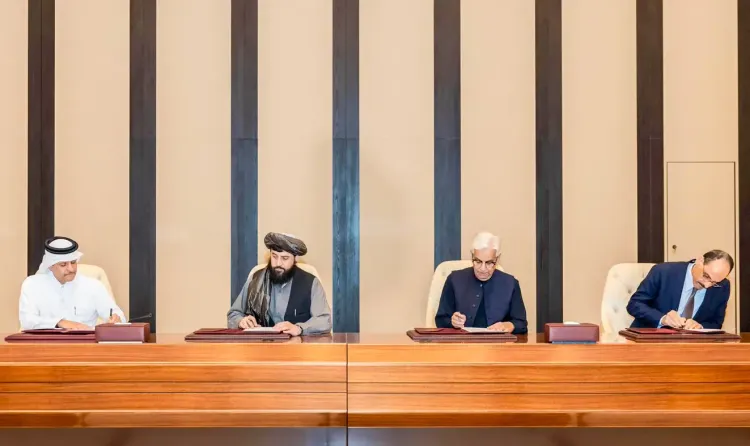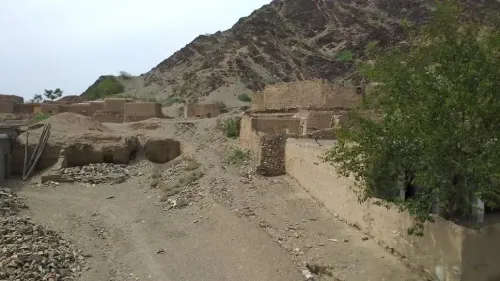Can a Ceasefire Bring Lasting Peace at the Af-Pak Border?

Synopsis
Key Takeaways
- Afghanistan and Pakistan have reached a ceasefire agreement.
- Ongoing negotiations aim to establish lasting peace.
- Next review meeting is set for October 25.
- Significant transit routes lie along the Durand Line.
- Historical tensions have influenced current diplomatic efforts.
New Delhi, Oct 19 (NationPress) Afghanistan and Pakistan have reached an agreement for a ceasefire after days of lethal cross-border gunfire that resulted in numerous civilian casualties and displacements along the Durand Line, which delineates the two nations.
The truce emerged from discussions held in Doha, facilitated by Qatar and Turkiye.
This agreement will be succeeded by further meetings "to ensure the sustainability of the ceasefire and verify its implementation in a reliable and sustainable manner," as stated in an official release.
According to Qatar’s Ministry of Foreign Affairs, "the two sides agreed to an immediate ceasefire and the establishment of mechanisms to consolidate lasting peace and stability between the two countries" during negotiations.
Thus, the Doha meeting marks the initial step towards restoring peace and mutual trust between the erstwhile friends turned adversaries.
The upcoming review meeting is anticipated on October 25.
Islamabad has consistently accused Afghanistan’s Taliban regime of harboring the Tehreek‑e‑Taliban Pakistan (TTP) and collaborating in cross-border assaults on Pakistan. In response, Kabul denies these claims and accuses Pakistan of violating airspace and territory, as well as conducting bombings within Afghanistan.
Shifting political dynamics in Islamabad have influenced the government's stance, with the current administration attributing blame to past leaders for their "dirty work" in collaborating with “Western countries” in mobilizing the Mujahedin militia against Soviet forces in Afghanistan.
Support for the Taliban is also being traced back to the former Imran Khan government, with other Prime Ministers – including Shehbaz Sharif's brother, Nawaz Sharif – having held power during the Taliban's rise and initial capture of Kabul from 1996-2001.
Initially established in the mid-1990s in Afghanistan’s Kandahar, the Taliban primarily consisted of students from Pakistan’s madrasas, benefiting from implied support from Islamabad at that time.
As a landlocked nation, Afghanistan relies heavily on transit routes with its neighboring countries, with two significant passages located along the Durand Line.
One of these routes, at Spin Boldak in Kandahar province, experiences substantial traffic with Chaman in Pakistan’s Baluchistan, serving as a conduit for goods and aid entering Afghanistan through the Gwadar port.
The other critical route connects Torkham, linking Afghanistan’s Jalalabad to Peshawar in Pakistan.
While Afghan refugees, displaced by Islamabad, have been crossing the borders, it will take time for normal business activities to resume following the recent bouts of violence, which escalated into major confrontations earlier this month.
Recent tensions have surged across various border sectors following Pakistani airstrikes on Afghan territory.
Authorities from the Taliban claimed to have inflicted significant losses on Pakistani troops, whereas Pakistan asserted that it had successfully repelled substantial assaults.
Meanwhile, Afghan media, citing official sources, reported civilian fatalities and numerous injuries in border districts amid the clashes and subsequent strikes.
The region has a history of cross-border skirmishes, with the one in April 2022 marking an early instance of confrontations post-Taliban takeover. Fierce fighting was also reported at the Chitral border in Pakistan’s Khyber Pakhtunkhwa in early September 2023.
A series of attacks and counterattacks unfolded across numerous frontier zones last year, with Kabul alleging Pakistani strikes within Afghan territory, which the Taliban reportedly retaliated against. Islamabad, on the other hand, reported persistent cross-border assaults and militant incursions, followed by Pakistani operations in late 2024, resulting in border closures and diplomatic protests.









